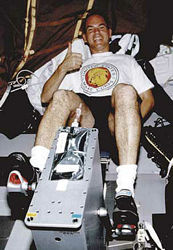
Sidebar - From Fiction to Fact: Space Station Alpha
By the standards of Earth orbit, the traffic outside the International Space Station may resemble the congestion found on the 520 ramps to and from Montlake Boulevard. More than 40 flights are scheduled in the next few years to turn the space station into a dorm and laboratory orbiting 250 miles above our heads.
If all goes according to schedule, the space station will be completed in 2006. It will stretch longer than a football field. The station's total cost has been estimated at $96 billion, including all the construction flights.
The space station is considered a vital part of space medicine research. Even on the first mission, astronauts are monitoring each other for changes in their bodies because of space.

Astronaut Frederick Sturckow works out on the space shuttle's bicycle ergometer. NASA photo.
"We expect to be a big user of the space station, come 2004 and 2005," says Ronald White, associate director of the National Space Biomedical Research Institute in Houston.
Scientists want to study the effects of zero gravity on humans, such as the loss of bone density and muscle mass. They also want to test many of the methods that might be used for alleviating some of these problems.
For one thing, a centrifuge on board will allow researchers to simulate the gravity conditions that would be found on Mars, which has a little more than one-third of Earth's pull. So the space station is seen as a crucial place for training and rehearsing for a Mars expedition.
Sixteen countries are cooperating to build and staff the station. The station will have more than half an acre of solar panels to power the station. It will have six times more electrical energy available than its immediate predecessor, the Russian Mir. Two computers on board are in charge of keeping the station on the right course and altitude as it orbits the Earth every 90 minutes.
By the time it is finished, the space station will have 46,000 cubic feet of living and working space—more than the volume of the passenger cabin and cargo hold of a Boeing 747-400, says the Boeing Co.
Boeing is well qualified to make that claim, as it is the station's prime contractor. Boeing built Unity, a connecting module that is in orbit today. All future U.S. segments of the station will be attached to Unity. Earlier this year, the space shuttle Atlantis delivered Boeing-built Destiny, a laboratory that will allow scientists to study how materials form in zero gravity.
It's possible that the space station will become a departure and return point for future astronauts going to Mars. "We might someday use the space station as a weighing-in spot—no pun intended—for astronauts coming to and from other places," says Yvonne Darlene Cagle, '85, a physician and U.S. astronaut. —Walter Neary
Go To: Page 1 | Page 2 | Page 3 | Page 4
- Sidebar: From Fiction to Fact: Space Station Alpha
- Return to March 2001 Table of Contents